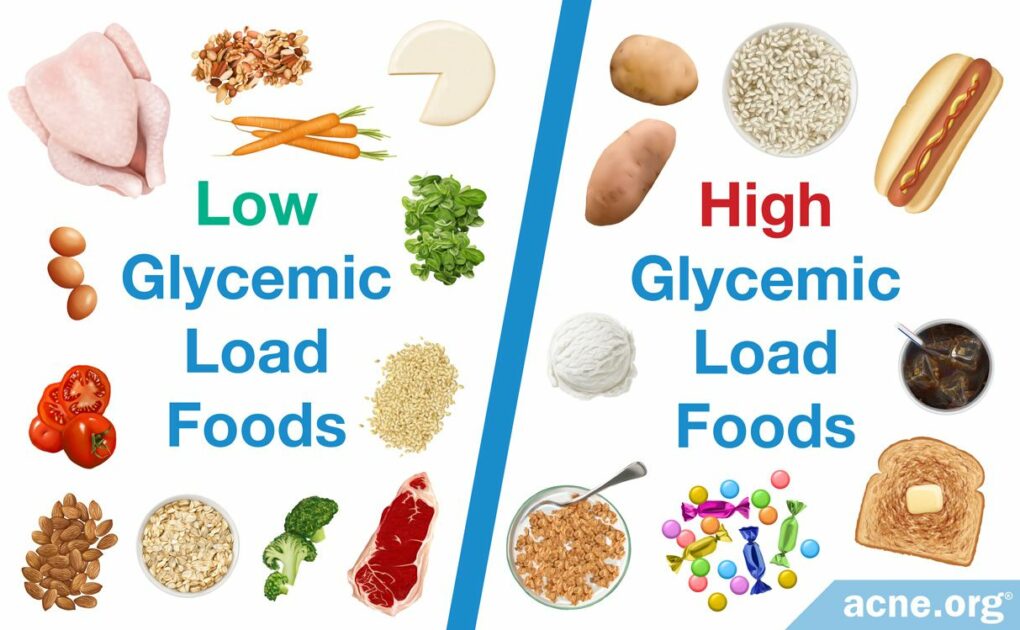Preventing Blood Sugar Spikes May Help Reduce Acne

The Essential Info
A high glycemic diet is one that is, generally speaking, high in sugar/carbs and processed foods.
This type of diet leads to spikes in blood sugar levels which causes a cascade of hormones and inflammation that some scientists suspect may lead to increased acne symptoms.
A small collection of research now exists surrounding this idea, and while some of the research is contradictory, the preponderance of the evidence is pointing toward this being a real possibility.
Because the amount of evidence supporting the link between a high glycemic load diet and acne is growing, it may be useful for acne sufferers to try to eat a lower glycemic diet when possible. This means eating a diet rich in:
- Fish/Meat/Poultry/Eggs
- Vegetables
- Nuts
- Oils & other fats
It also means reducing the amount of high glycemic foods, such as:
- Processed foods
- White bread/White rice/White potatoes/Pasta
- Crackers/Pretzels
- Pulp-free juices
- Candy
- Soda
My Experience: Throughout the years, I have tried every possible way of eating low-glycemic and carefully monitored my skin as I did it. I tried eating strictly paleo for 2 months and it helped clear my skin, but not completely. I have also tried being strictly keto for 6 months and that also helped clear me up, but not completely. I even tried being strictly carnivore for 2 months, which also helped me clear up, but again, not completely. However, the science is compelling that keeping blood sugar levels in check by eating low-carb should theoretically help reduce acne and offer a host of other health benefits, so I still eat low-glycemic most of the time. But I also make sure not to get too obsessed with it. If I go to my cousin’s house and she cooks amazing Persian dinner with rice and desert, I’ll indulge a bit and then get back on the low-glycemic wagon the next day when I’m able to choose my own food.
Fun Tip: Drinking apple cider vinegar after a high glycemic meal may help reduce a blood sugar spike. You can buy it at any supermarket, and it could be a fun superhero that can fight blood sugar spikes. Ask your doctor if drinking apple cider vinegar is safe to use with any oral medication you are taking, and if you get the green light, feel free to mix 1-2 tablespoons of it in 8 ounces of water (add stevia if desired for sweetness) and drink it right after you eat high-glycemic food for a little added insurance against blood sugar spikes.

The Science
- Glycemic Index & Glycemic Load Defined
- The Studies: Research Connecting Glycemic Load and Acne
- Research Limitations
- How Glycemic Load Might Affect Acne
- The Bottom Line
Professionals within and outside the medical community have long believed that a person’s diet might affect acne.
Why else, some experts argue, would 9.4% of the world’s population at any given time have acne when some cultures, like the populations of Tanzania, natives of Okinawa Japan, Canadian Intuits, and South African Zulu populations have amounts hovering around 1%? Adding fuel to the fire, scientists have found that acne increases in these populations after exposure to a Western lifestyle, which includes diets consisting of processed foods, dairy, and simple sugars.1,2
As researchers have attempted to understand the relationship between dietary sugar and acne, increasing amounts of data have accumulated linking a high-sugar or high-processed carbohydrate diet to acne development. This type of diet is called a high glycemic diet.
However, due to the lack of large, long-term, controlled trials, scientists have been unable to definitively confirm the link between a high glycemic diet and acne. Therefore, doctors have not yet widely implemented diet as an acne preventative or treatment. Still, there is some evidence that shows us that a high glycemic diet may be connected with increased acne symptoms.
Let’s start by breaking down a high glycemic diet into its parts: glycemic index and glycemic load.
Glycemic Index & Glycemic Load Defined
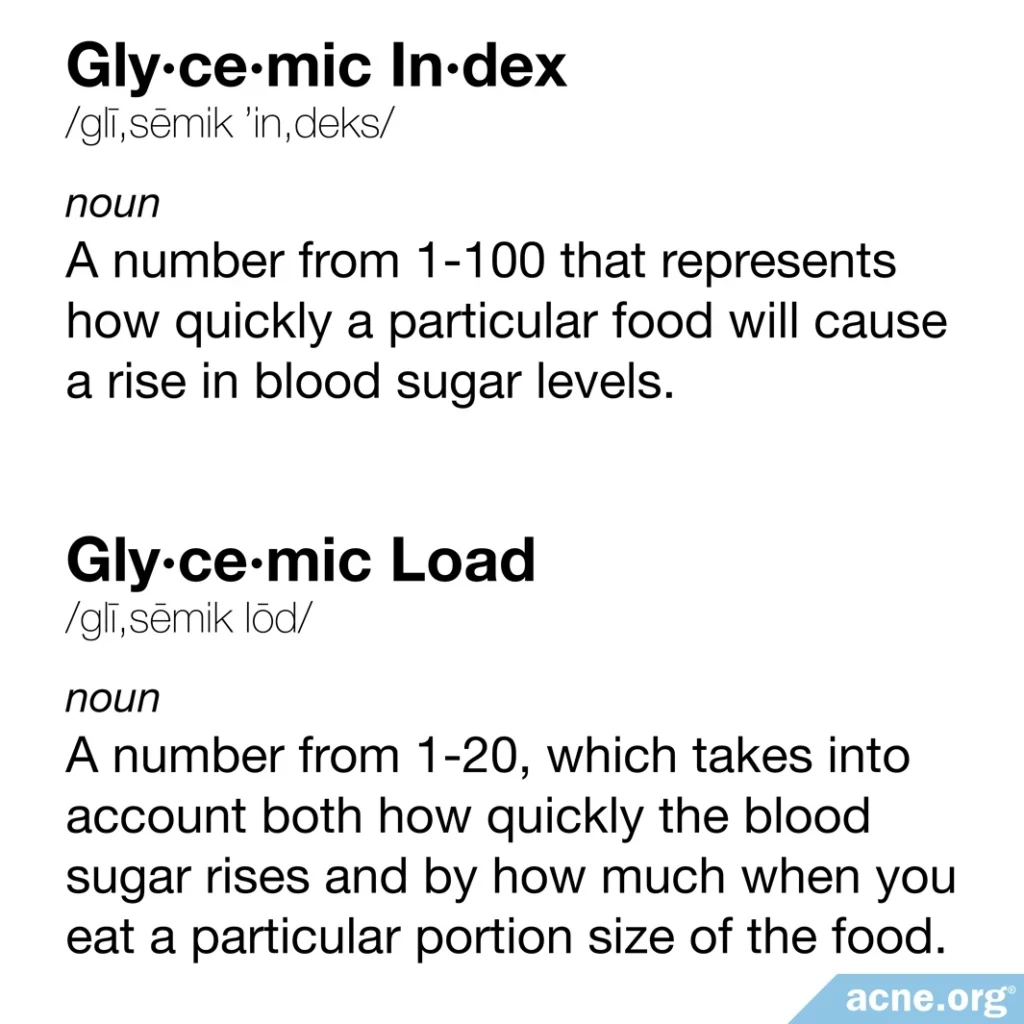
Glycemic index and glycemic load are two measures of a food’s ability to spike blood sugar levels. Although similar, each measures a slightly different capacity, and when it comes to acne, it is the glycemic load that is of concern.
Glycemic Index
The glycemic index (GI) is a number from 1-100 that represents how quickly a particular food will cause a rise in blood sugar levels.
When a person eats a food with a GI of 100 (e.g. glucose) it will cause an extremely quick spike in blood sugar, whereas eating a food with a GI of 1 (e.g. bean sprouts) will cause a very slow rise in blood sugar.3
Glycemic Load
The glycemic index of a food only tells part of the story. It tells us how quickly the blood sugar spikes but not by how much – this is where the glycemic load comes in.
The glycemic load (GL) is a number from 1-20, which adds onto the glycemic index by taking into account both how quickly the blood sugar rises and by how much when you eat a particular portion size of the food.
For instance, watermelon has a high glycemic index (72), but a typical serving of watermelon does not contain a lot of carbohydrates, which means the blood sugar doesn’t rise by much, and therefore, the glycemic load is low.4
In other words, sometimes a food, like watermelon for instance, might have a high glycemic index, which means it makes blood sugar rise quickly, but has a low glycemic load, which means it does not cause the blood sugar to rise by much. Ultimately, what matters is how much blood sugar rises. Therefore, glycemic load is what we need to look at when it comes to acne.
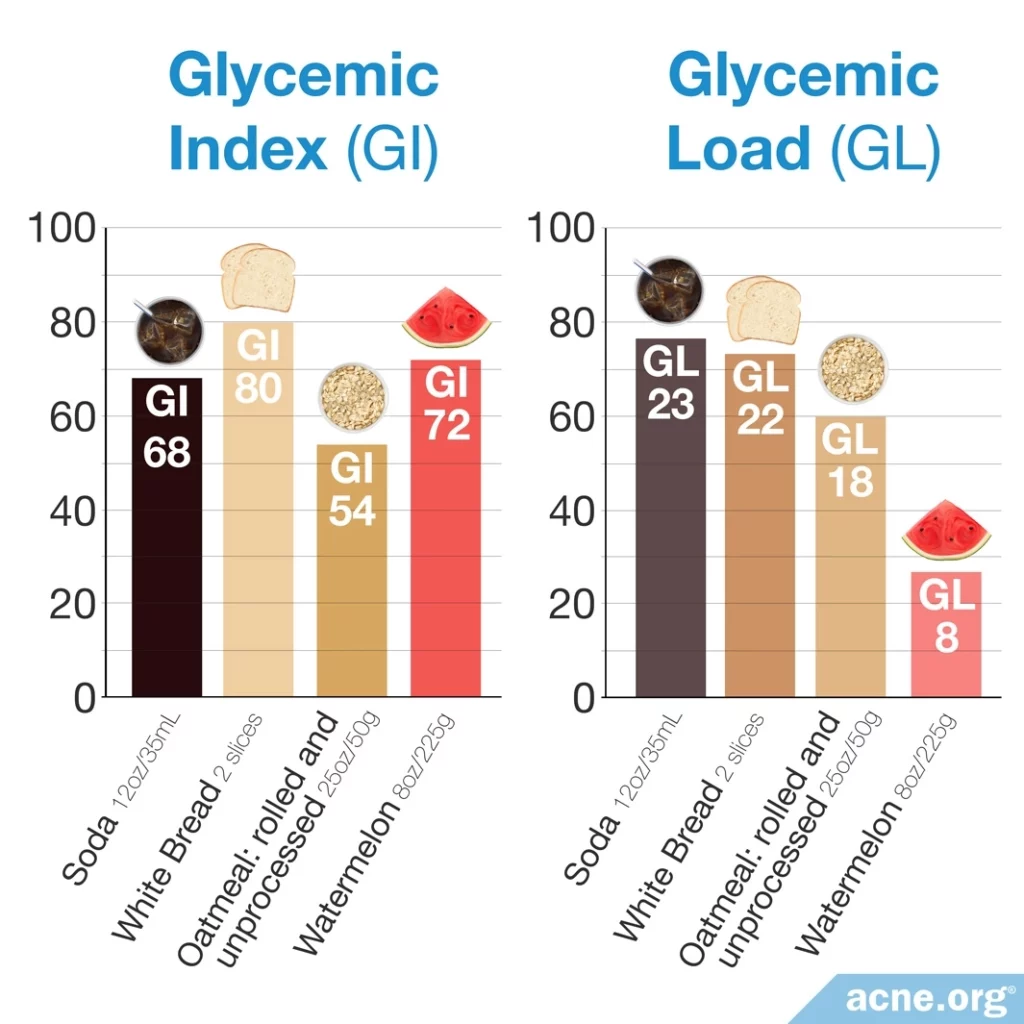
Foods both high on the glycemic index and glycemic load include foods like soft drinks, candy, or bread, with large amounts of processed sugar or carbohydrates.
Foods both low on the glycemic index and glycemic load include foods like vegetables, meat, some fruits, and beans.
Foods high on the glycemic index but low on glycemic load include some fruits like watermelon and pineapple, and some vegetables like carrots and pumpkin. You might have heard that these foods are “bad for you” before because they have a high glycemic index, but they are not. They have a low glycemic load, which is what really matters.
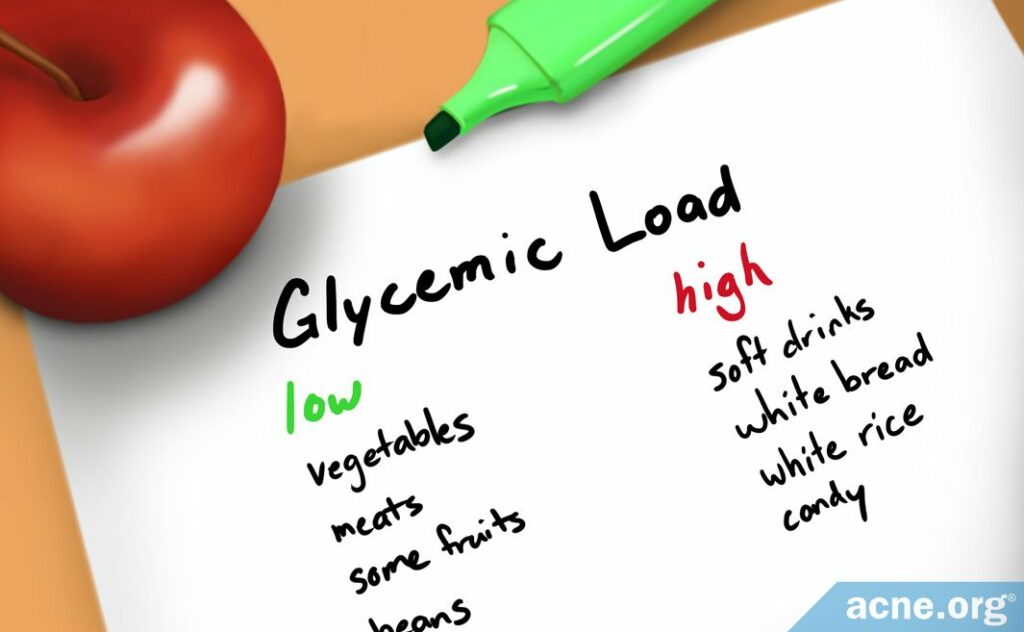
The Studies: Research Connecting Glycemic Load and Acne
Scientists have performed 12 studies investigating the link between glycemic load and acne.
- 9 of the 12 studies concluded that a potential link between high glycemic load diets and acne development may exist.
- 3 studies found no such association.
So, the preponderance of the evidence at this point, albeit tentative, seems to point toward a connection.
Expand to read details of studies
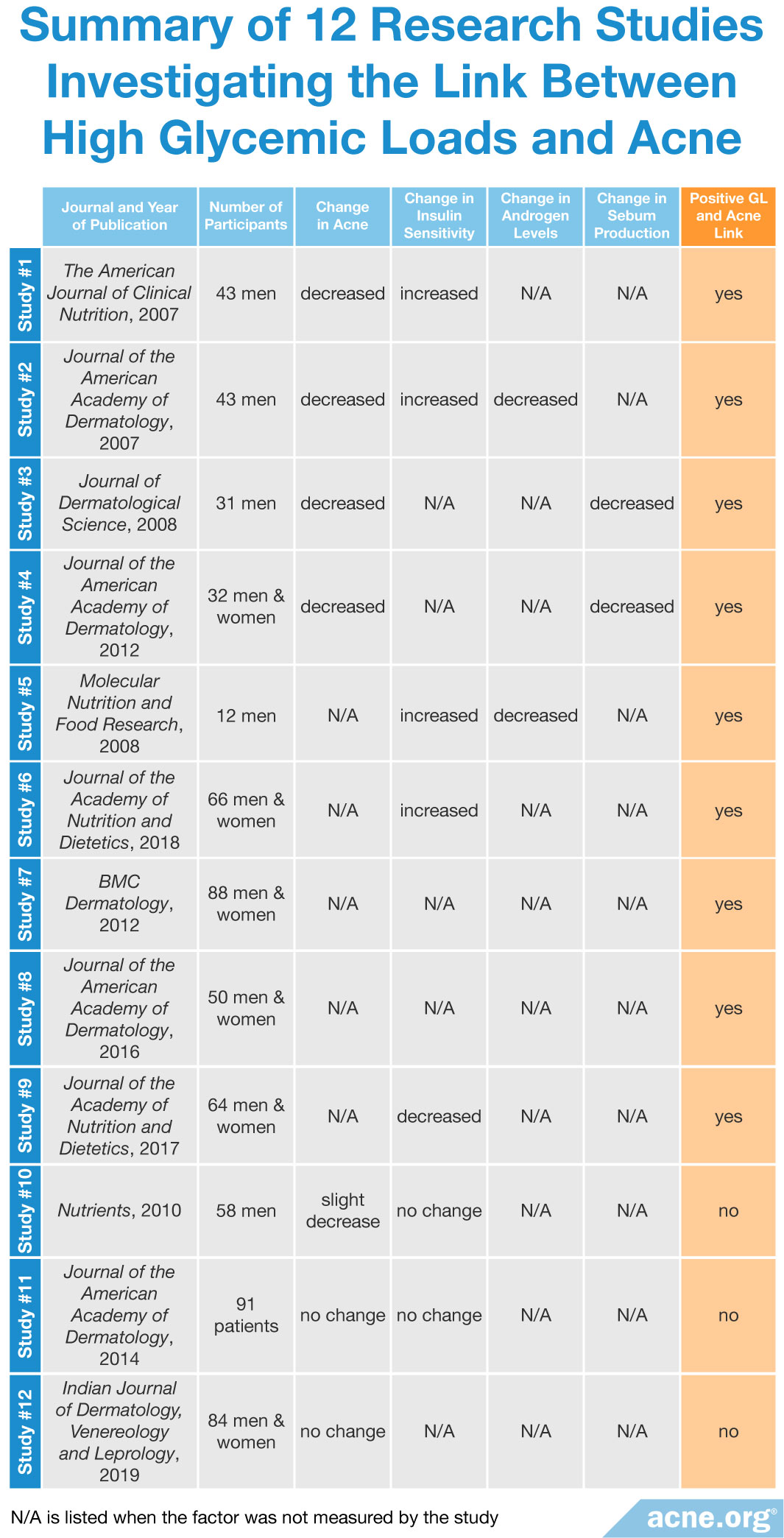
Research Limitations
Although nine studies have identified a potential link between glycemic load diets and acne, these studies are not proof that a high glycemic load diet causes acne.
This is because all those studies are small (less than 100 subjects) and have confounding factors like patient weight loss caused from the low glycemic diet. Weight loss can cause the body to become more insulin-sensitive and thus improve acne in the short term.
These study flaws, among others, prevent researchers from making a general conclusion about high glycemic diets and acne. Therefore, scientists will need to perform additional studies, including at least one large, randomized trial, in order to more definitively claim that high glycemic load diets cause acne.
However, for now, the evidence may point toward a connection. Let’s look now at the science behind exactly why a high glycemic load diet might increase acne.
The Science: How Glycemic Load Might Affect Acne
Eating a high glycemic load food increases the level of sugar in the blood. When the body senses there is a high level of blood sugar, it responds by producing insulin, which helps the body use and store the sugar. The presence of insulin then triggers the activation of a variety of responses in the body, which might potentially lead to an increase in acne.
Okay, here comes the deep science…One major response is the insulin-induced suppression of a protein known as FoxO1. The normal activity of FoxO1 is to inhibit androgen activity and also lower production of important sebum components called fatty acids. A rise in insulin leads to a suppression of FoxO1 and therefore increased androgen activity and production of sebum. A second major response to increased insulin is the insulin-induced stimulation of a protein known as mTORC1. The normal activity of mTORC1 is to promote the production of sebum. Therefore, a rise in insulin will increase the activity of mTORC1 and increase the production of sebum.1
Eating a high glycemic load diet leads to an increase of insulin, which suppresses FoxO1 and activates mTORC1 pathways. These pathways may result in an increase in sebum production, making the skin oilier, which could in turn promote the growth of acne bacteria. Therefore, some scientists predict that consuming a low glycemic diet will result in decreased levels of insulin and in turn a decreased amount of sebum, bacteria growth, and acne.15
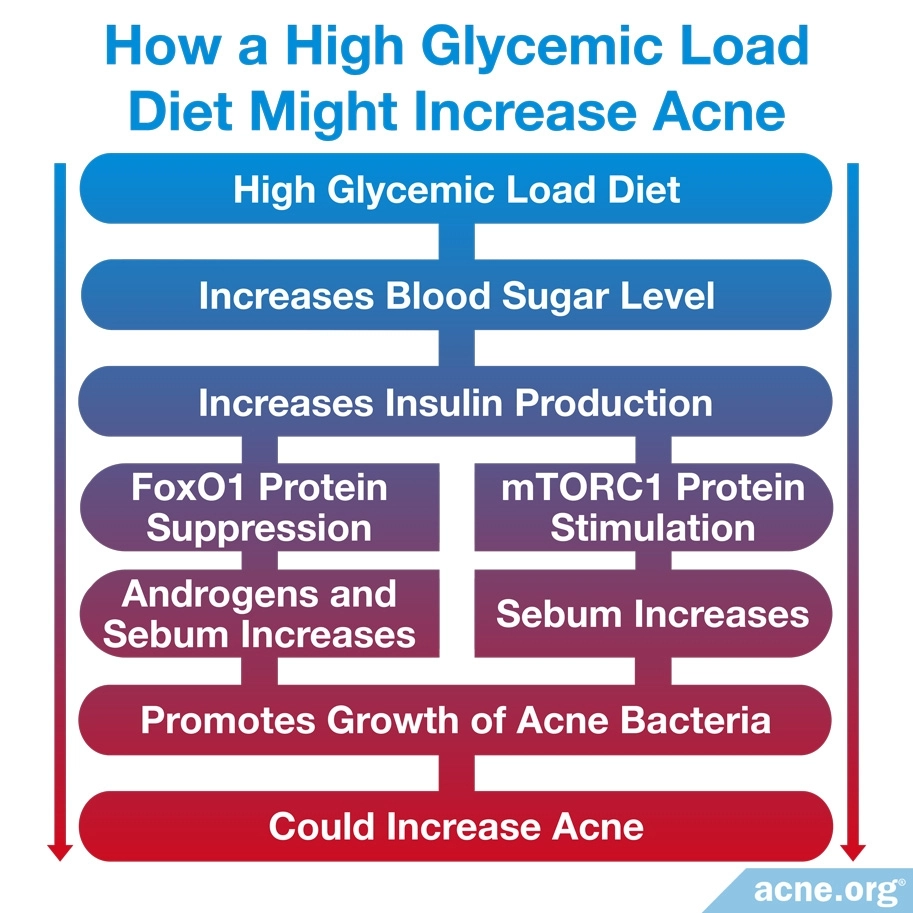
The Bottom Line
Because it is so hard to study the effects of diet on disease, we still don’t know definitively whether eating a low glycemic diet will improve acne. But since the preponderance of the evidence points toward this possibility, and eating a low glycemic diet is healthy regardless, it can’t hurt to try to eat more unprocessed, whole foods whenever possible. While you should not expect a dramatic reduction in acne simply from changing your diet, consuming a low glycemic diet might help at least to some degree.
Eating low glycemic means eating more vegetables, whole fruits (not juice), nuts, beans, meats & fish, and unprocessed whole grains.
